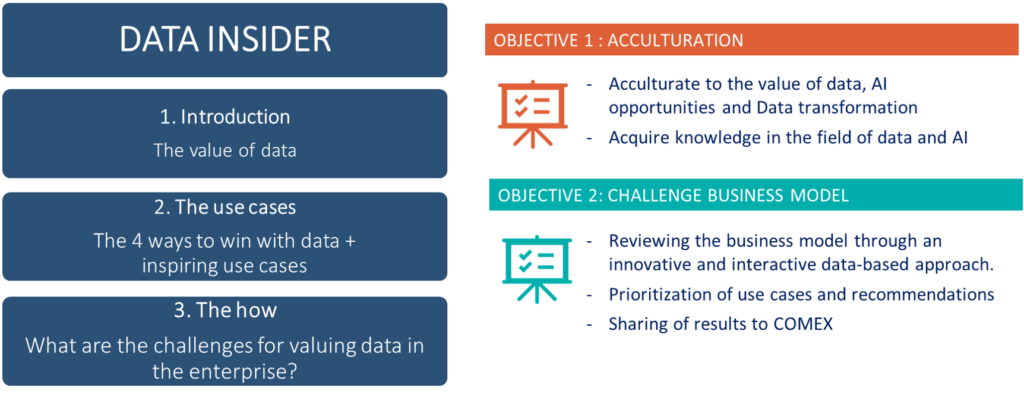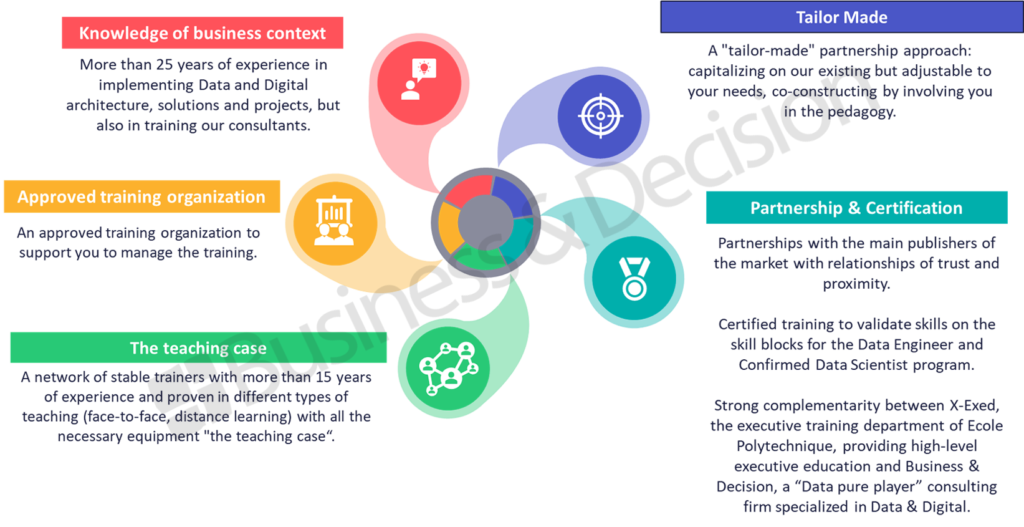It is crucial to pay a particular attention to the use and adoption of Data Governance regarding any new initiative, whether it is an innovation or the deployment of a new product line. Data Governance represents a major change among the company, and we all know that the more Data Governance is adopted, the more likely it will be used by a large number of people. Pierre-Charles, our expert in Data Governance for more than 15 years explains in this blog article how to develop a successful and sustainable data culture within the company.

How to adopt a data-driven culture?
In the way to success, engaging with employees is a crucial pillar that needs to be well prepared with a good vision (i.e. a good data strategy). The first key element of good adoption is to pass the right message to the right people in the organization. To answer this challenge, the best option would be to work with one hybrid data team which will include a mix of experienced employees and freshly hired data experts. On one side you will take full benefits from the network and the understanding of the company challenges; and on the other the data experts will translate your business pain points into tangible data topics.
In regards to this methodology, we can highlight 5 key steps to build a data culture:
- Study phase and sharing the vision
- Data Evangelization
- Operational pain points and requirements identification
- Project implementation
- Change management & deployment
The more Data Governance is adopted, the more likely it will be used by a large number of people.
Assessment of your key data pillars
All good adoption of data culture starts with a study phase with maturity level assessment and the building of an elevator pitch. The maturity level assessment on the key data pillars (data governance, data quality, data management, data privacy, data integration, data preparation, analytics), based on your current operational challenges and business pain points, will enable you to identify the priority data topics to be put on your roadmap.
During the elaboration of the roadmap, it is very important to define tangible objectives, deliverables and solutions that will speak to the business and will ring the bell in people’s mind with concrete operational benefits. From these priority topics, and from the overall corporate strategy, we will elaborate an elevator pitch that will be used for explaining the objectives and the high-level roadmap to the C-level first, then to heads of functions, and finally to operational teams. No sponsorship, no credibility!
Evangelize a data-driven culture
There is a mandatory step of evangelization through the top-down levels of the organization pyramid to explain:
– WHY we do implement data governance in the company
– WHAT are the different components of the approach with their benefits
– HOW we are going to proceed (i.e. high level roadmap).
This step is very important to get the concerns and the feedback from the various levels and stakeholders. Along the evangelization journey, the pitch and the presentation can be adjusted in regards with the remarks of the business stakeholders.
It’s crucial that you define a data governance that answers strategic objectives and operational pain points, and that all employees in the organization understand WHY such a transformation.
Identify your business priorities & objectives
After validating the global approach with priority topics, you can start the implementation of projects, like MDM or analytics, by gathering your operational pain points and new requirements from the operational teams. This will enable you to identify clearly the business objectives and priorities and turn this into a high added-value data solution that will answer their operational needs.
The outcome of this step is the definition of a clear list of objectives and success criteria for an upcoming agile sprint. This will also help you to define the requirements and items to be added to a Scrum product backlog.
An agile project implementation
Nowadays, most data projects are done following an agile or scale methodology. The data owners and operational teams must be fully involved in the project execution through regular reviews, the prioritization of the product backlog and through regular intermediate solution development demos.
This strong involvement and this close collaboration with the key users will prepare the future adoption of the tool and will enable a tailored-made design of the solution that really answers their business needs. The more you go into the project implementation with them, the more they feel how the “TO-BE” organization and maintenance process will be.
Along the implementation, you will also capture the concerns of your key users that will help the change management team to identify the hard points and the showstoppers to be tackled in the training material.
Get a final GO before the deployment
This is also a very important step for supporting the adoption before the business go-live. Before conducting training and testing, I always suggest doing a final round with the business sponsors and the head of functions in order to answer their last questions and to get their “blessing” before the deployment.
During this phase, you will present them the final solution and the organizations or processes changes that will be deployed. From there, you can organize the User Acceptance Testing (UAT) and the training phase ensuring that everyone feels comfortable with the future solution.
Increasing the intimacy and reaching out to the full company
If you perform this full journey, that can last several months across several project iterations, you will really target the business needs and make your data solution very appropriate for your own business context. For data adoption, the users’ satisfaction is key, otherwise you will lose them.
In addition, I could often see very good results with open training programs for the entire company that enable to pass on the message. Another good idea is to organize events such as “data open days”. This is a good opportunity to receive any employee who wants to participate where you can present them the data strategy and answer their individual questions. To go further, here is an overview of some additional communication and training activities that you can perform in your organization:
- Selling pitch and communication plan – you can define a selling pitch for both C-levels and business operational teams. Next to this you can add an associated communications plan to explain the WHY-WHAT-HOW.
- User interviews – all along the journey, you can organize interviews with a selected audience. This is a real opportunity to present the data governance initiative and to listen to end users to gather their operational pain points to make it more impactful and more effective.
Change management occurs all along the data journey and it’s important to establish intimacy and trust with the end users.
- Open training program – in collaboration with your training department, you can organize an open training program for everyone (online or onsite) that will enable all employees to be aligned on the same page and to have all the tools and methodology for succeeding in this global data transformation.
- Open data days – online or onsite, you can organize 2 days of 1:1 sessions open to the whole organization where anyone can join, you present the vision and the ongoing initiatives, and they can ask their questions.
The main challenge is not only technical!
To conclude, I would say that the data culture adoption is a success when you go through a good communication of your data strategy to the different levels of the organization, you onboard key users in the implementation of your data projects, and you prepare the change management during all phases of the program implementation. Technical stuff and project management are not critical, this is really the communication and the change management that is crucial in the deployment of enterprise data governance.
At Business & Decision, we are used at evangelizing the data culture and dealing with change management. Our 2500+ pool of data experts are trained for listening to the stakeholders, gathering their requirements and operational pain points, and shaping vision and solutions which meet their needs.
We propose a complete support for business and can mention the two following ones that are very relevant for making the data culture and the enterprise data governance widely adopted and used in the company:
- Data Insider – this is a 1-2 days workshop to acculturate the top management and the sponsors and to identify development opportunities for data with a Design Thinking / Innovation approach.

- Data School – this is a complete training programme with several training sessions organized for the business and IT stakeholders with a mix of presentations and hand-on sessions on the different data pillars: fundamentals, data management, data analysis, data preparation & visualization, learning experience, post-training support.

And you, what is your point of view about this topic? Do you have other best practices that enabled you to turn a data transformation programme into success?
















Your email address is only used by Business & Decision, the controller, to process your request and to send any Business & Decision communication related to your request only. Learn more about managing your data and your rights.